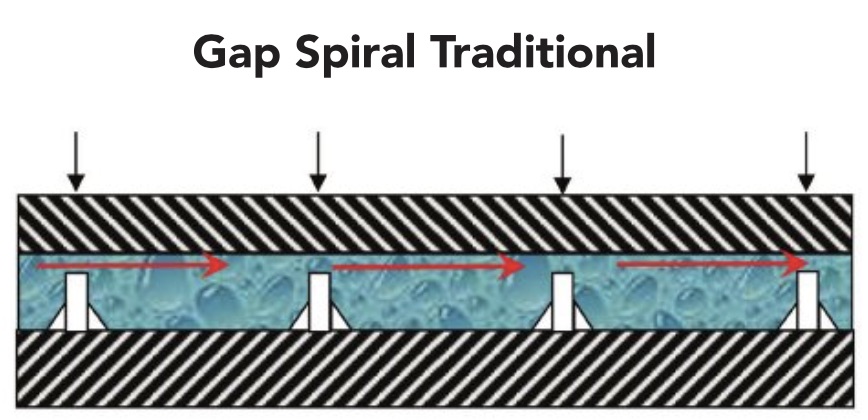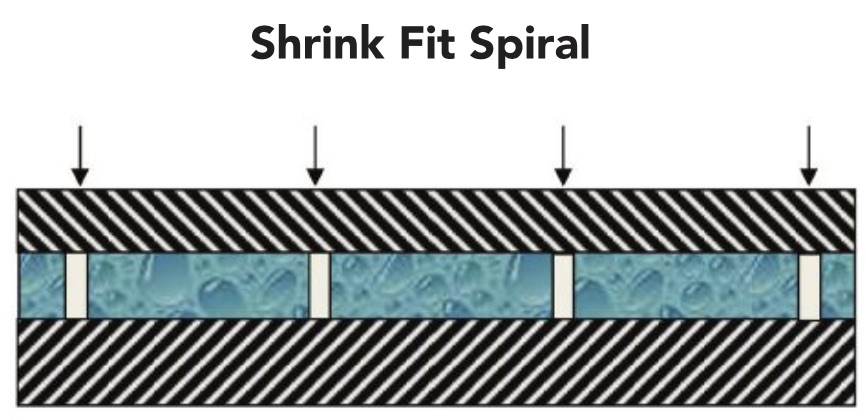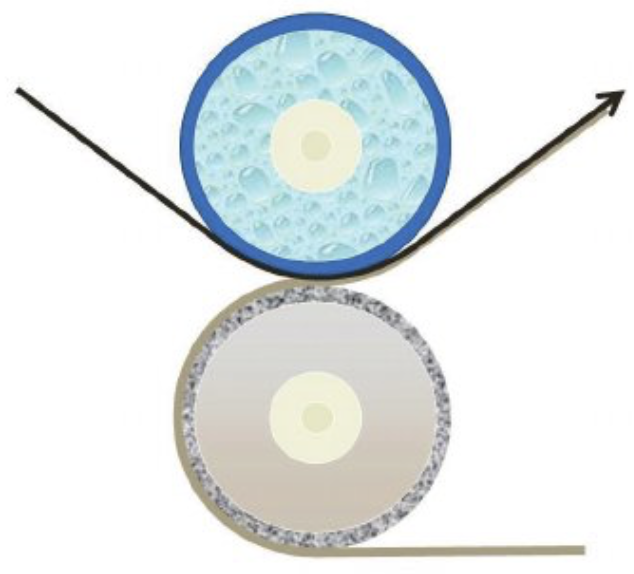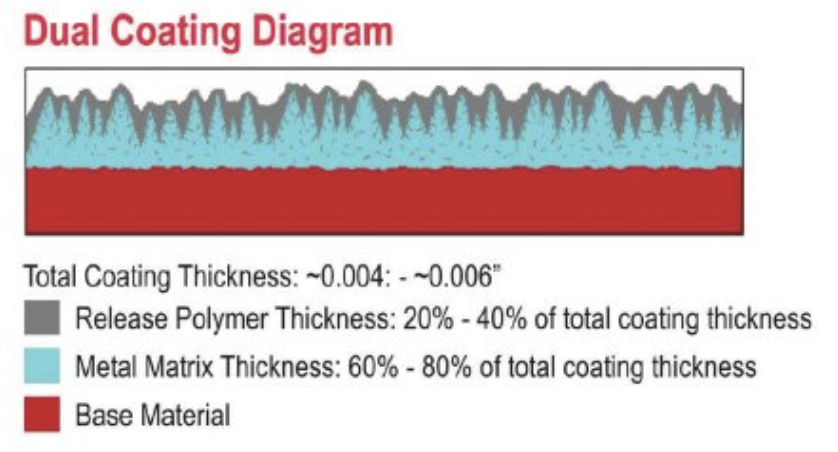Thermal Transfer Core Design and Performance in Today’s Markets
- Published: January 24, 2022
By William R. Bradley Jr., Vice President, Business Development, American Roller Company
Since the 1950s, converters within multiple markets have relied on Thermal Transfer Roller performance to enhance products, add critical properties and increase speed and efficiency in their process. Over the years, the designs have evolved to meet the demand of increased production and expand end user/consumer options. The functionality is rather simple; the surface of the production roller either produces a heated or cooled surface for web to accomplish embossing, lamination or extrude plastics. As simple as this sounds, the path to achieving optimal performance can be complex.
When cooling the roller surface, heat is pulled out of the substrate, creating a change in properties. It can cure the web into a solid state, or prepare it for the next treatment, including lamination or coating. When heating the roller surface, this creates a condition for the web substrate to accept chemistry, change physical elasticity or prepare for multi-layer formulation. In some unique applications, the thermal transfer roll surface is still heated, however it is “cooling” the web substrate (at a much higher temperature). This is commonly known as controlled cooling, and usually occurs with the web substrate transporting over multiple Thermal Transfer Rollers at various angles, to achieve optimal curing condition.


DESIGN OPTIONS
Today’s converter has different “internal designs” to consider. The illustrations represent a traditional, commonly used, “Gap Spiral” design. The channels are often custom engineered to maximize flow rate and performance. Benefits include lower cost, and for less critical applications has an acceptable level of reliability and performance. Limitations include thermal transfer predictability and non-sealed channels allowing fluid bypass. It is also noted, this design is limited to lower loading applications, where the outer shell is unsupported by the inner assembly.
For advanced applications, especially requiring high load performance, a “Shrink Fit Spiral” design should be considered. Benefits include a positive seal between the inner assembly and outer shell controlling fluid flow, extremely predictable and uniform surface temperatures, and full load distribution across the face of the core.
There are advanced steps in the manufacturing process to construct a shrink fit internal design vs gap spiral. First the outside channels (OD) of the inner assembly are precision ground to a specified diameter. Then the inside diameter (ID) of the outer shell is precision bored for an interference fit with the inner assembly.
A heat induction process allows the outer shell to expand temporarily, while the inner assembly is installed. Once cooled, this provides an extremely precise and stable interface. In final steps to complete fabrication, journals, roll diameter and any other critical areas are precision ground to tolerance.
In some advanced applications (sometimes seen in the flexographic packaging & printing market), Thermal Transfer Core performance is merged with air mandrel and sleeve technology. Air mandrel and sleeve systems were developed for manufacturing flexibility when converting multiple web substrates and widths. Along with quick change options when damage or wear occurs, it also allows the converter to stock an inventory of covered sleeves vs entire roll cores.
 Engineered Surface Options for Today’s Converter
Engineered Surface Options for Today’s Converter
Rubber / Elastomeric
Selecting the optimal Thermal Transfer Core design is the first step to a successful application, but often the outer covering or surface coating will determine the speed, efficiency and quality of the finished web substrate. Most applications nipping by nature require a hard face roller against a rubber or elastomeric covered roller. This is common in embossing, laminating and coating of a substrate. With the illustration, we see a Chilled Core design where the outer covering is rubber. The core can have maximum thermal transfer to the surface of the steel, but if the rubber covering is not thermally efficient, this can adversely affect the temperature transfer to the surface. There are specifically engineered elastomerics such as silicone deemed “thermally conductive” to improve this condition. Not only do they have efficient thermal transfer but offer release properties in higher temperature environments.
Plating and Engineered Coatings
In other applications the thermal transfer roller can be bare (green), Chrome Plated, Ceramic hardfaced, or Plasma Coated. The desired surface finish can sometimes dictate the coating selection. Traditionally Chrome Plating has been used for decades as the “go to” surface treatment. It offers excellent temperature transfer, is harder than the base core, and is available in a variety of surface finishes. For an engraved surface roller, the plating process follows the engraved pattern, providing a protective outer layer without distorting the desired embossment. Challenges with Chrome Plating include corrosion resistance, especially in chemical or coating environments. Microscopically, Chrome Plating has micro-cracks, sometimes allowing penetration to the base core. Please consult with your roll professional if you feel this could be a concern.
Ceramics and Plasma Dual Layer Coatings continue to grow in popularity as engineered solutions for thermal transfer roll applications. Ceramics, often in the 63-65 Rockwell C hardness range offer excellent abrasion resistance. Ceramics are naturally porous, however new sealers are being applied to assist in reducing or eliminating corrosion-resistance risks. They can be precision ground to a wide range of surface finishes, 5RA-250+. Limitations include high impact applications with risk of damage on the roller surface in smaller concentrated areas. Slitting blades or knives of this type should never be used on ceramic surfaces.

Applications requiring ultra-hard, abrasive resistant surfaces have benefited with the use of thermal sprayed metal matrixes, otherwise known as Plasma Coatings. Base coatings can be offered up to 72 Rockwell C in hardness but can also offer excellent traction and release properties. This can be critical when wanting to achieve maximum speed in a heated or cooled application. Often there is affinity between the web substrate and the roll surface, where a dual layer coating can be a game changer. In the diagram, we see the makeup of this dual layer system. Notice the release polymer penetrating not only the valleys of the profile, but also embedded in the porosity of the metal matrix. This increases strength and mechanical integrity, resulting in reliable performance for years.
Limitations within these systems include specific RA surface finishes lower than 50 RA. Also, the addition of polymer can affect thermal transfer rates. Please consult your roller professional before deciding on this type of surface.
For today’s converter, there is a wide selection of thermal transfer design and surface treatments to consider. Both go hand in hand when trying to maximize your application. There are many details to consider, but with the right formula, speeds can increase, waste can be reduced, and defects can be kept to a minimum.












